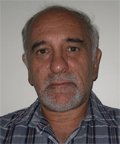Eduardo D. Sontag: Difference between revisions
(Created page with "== Biography == Eduardo D. Sontag’s contributions to nonlinear feedback for control and signaling systems opened the floodgates to creativity in nonlinear designs, benefiting...") |
No edit summary |
||
| (3 intermediate revisions by 3 users not shown) | |||
| Line 1: | Line 1: | ||
== Biography == | == Biography == | ||
Eduardo | [[Image:Sontag Eduardo.jpg|thumb|right]] | ||
[[ | Eduardo D. Sontag’s contributions to nonlinear feedback for control and signaling systems opened the floodgates to creativity in nonlinear designs, benefiting a wide range of engineering disciplines. Dr. Sontag’s control Lyapunov function (CLF), input-to-state stability (ISS), and related concepts help in the design of stable nonlinear feedback systems. Dr. Sontag presented the CLF concept in 1989 and it quickly pervaded the control literature. CLF’s provides control practitioners with the ability to make appropriate feedback control choices. Also in 1989, Dr. Sontag’s ISS concept helped tackle the difficulties presented by uncertainty in nonlinear systems. With ISS, he showed how to capture the effect of persistent disturbances in nonlinear systems, which has enabled engineers to solve many robust stabilization problems. An [[IEEE Fellow Grade History|IEEE Fellow]], Dr. Sontag is a professor with the Department of Mathematics at Rutgers University, Piscataway, N.J., where he is also in the graduate faculty of the Computer Science and the Electrical and Computer Engineering Departments. | ||
[[Category: | [[Category:Control systems|Sontag]] [[Category:Nonlinear control systems|Sontag]] | ||
Revision as of 14:51, 12 January 2012
Biography
Eduardo D. Sontag’s contributions to nonlinear feedback for control and signaling systems opened the floodgates to creativity in nonlinear designs, benefiting a wide range of engineering disciplines. Dr. Sontag’s control Lyapunov function (CLF), input-to-state stability (ISS), and related concepts help in the design of stable nonlinear feedback systems. Dr. Sontag presented the CLF concept in 1989 and it quickly pervaded the control literature. CLF’s provides control practitioners with the ability to make appropriate feedback control choices. Also in 1989, Dr. Sontag’s ISS concept helped tackle the difficulties presented by uncertainty in nonlinear systems. With ISS, he showed how to capture the effect of persistent disturbances in nonlinear systems, which has enabled engineers to solve many robust stabilization problems. An IEEE Fellow, Dr. Sontag is a professor with the Department of Mathematics at Rutgers University, Piscataway, N.J., where he is also in the graduate faculty of the Computer Science and the Electrical and Computer Engineering Departments.
